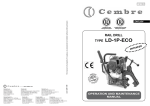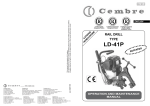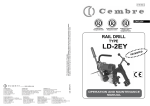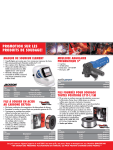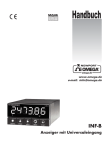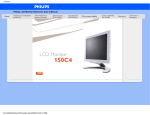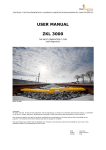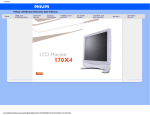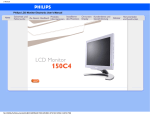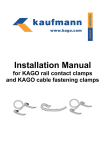Download Cembre LD-2EYGR Operating instructions
Transcript
www.cembre.com Cembre S.p.A. Via Serenissima, 9 25135 Brescia (Italia) Telefono: 030 36921 Telefax: 030 3365766 E-mail: [email protected] www.cembre.it Cembre España S.L. Calle Verano, 6 y 8 - P.I. Las Monjas 28850 Torrejón de Ardoz - Madrid (España) Teléfono: 91 4852580 Telefax: 91 4852581 E-mail: [email protected] www.cembre.es Cembre Ltd. Dunton Park Kingsbury Road, Curdworth - Sutton Coldfield West Midlands B76 9EB (Great Britain) Tel.: 01675 470440 - Fax: 01675 470220 E-mail: [email protected] www.cembre.co.uk Cembre AS Fossnes Senter N-3160 Stokke (Norway) Phone: (47) 33361765 Telefax: (47) 33361766 E-mail: [email protected] www.cembre.no Cembre S.a.r.l. 22 Avenue Ferdinand de Lesseps 91420 Morangis (France) Tél.: 01 60 49 11 90 - Fax: 01 60 49 29 10 B.P. 37 - 91421 Morangis Cédex E-mail: [email protected] www.cembre.fr Cembre GmbH Heidemannstraße 166 80939 München (Deutschland) Telefon: 089/3580676 Telefax: 089/35806777 E-mail: [email protected] www.cembre.de cod. 6261202 This manual is the property of Cembre: any reproduction is forbidden without written permission. Cembre reserves the right to make modifications and improvements to products without prior notice 09 M 065 E Cembre Inc. Raritan Center Business Park 181 Fieldcrest Avenue Edison, New Jersey 08837 (USA) Tel.: (732) 225-7415 - Fax: (732) 225-7414 E-mail: [email protected] www.cembreinc.com ENGLISH Certified Quality Management System RAIL DRILL TYPE Certified Environmental Management System LD-2E LD-2E-110 LD-4EF TED EN PAT OPERATION AND MAINTENANCE MANUAL DESCRIPTION OF THE DRILLS: INDEX page 1. General characteristics ....................................................................................... 3 2. Accessories supplied with the drill ...................................................................... 4 3. Accessories to be ordered separately ................................................................ 5 LD-2EN LD-2EN-110 LD-4EN 4. Type SR5000 coolant unit................................................................................... 9 basic drills 7. Rail drill type LD-2E; LD-2E-110; LD-4EF ..................................................... 14 5. Spindle advance lever ...................................................................................... 11 6. Preparing the drill.............................................................................................. 12 8. Drilling ............................................................................................................... 18 9. SPA... Positioning plate .................................................................................... 21 10. Storing the drill .................................................................................................. 24 11. Maintenance ..................................................................................................... 25 LD-2E 2E 110 LD-2E-110 LD-4EF 4EF 12. Warnings ........................................................................................................... 30 13. Return to Cembre for overhaul ....................................................................... 30 Appendix “A” ............................................................................................................ 27 basic drills complete with DBG-F2 railweb clamping ing device Appendix “B” ............................................................................................................ 28 Appendix “C”............................................................................................................ 29 1 34 1 1 1 1 2 2 2 2 2 4 2 4 1 1 1 1 1 1 1 1 1 1 1 2 2 1 2 1 1 1 1 1 1 1 1 Qty Description – Before using the rail drilling, carefully read the instructions contained in this manual. SAVE THESE INSTRUCTIONS: this manual contains important safety and operating instructions for the drilling machine. Code N° Item – The degree of protection of the drilling machine against moisture is classified “ordinary" (EN 50144-1 Standard). Do not expose the rail drilling to rain and moisture; possible infiltrations of water inside the electric motor determines the risk of electric shocks. Mobile electric devices used outdoor must be connected to the supply by interposing a safety interrupter for breakdown current. 29 27 26 25 31 33 36 6001155 6002871 6001762 6001768 6001769 6180201 6001776 6760378 6340612 6900314 6900348 6650144 6760222 6140082 6001138 6140082 6001775 6140080 6001137 6040421 6001156 6001907 6001906 6001757 6001772 6340160 6380310 6001150 6001151 6001659 6001152 6520422 6140085 6001145 6001281 37 36 35 34 33 32 31 29 28 27 26 25 24 23 22 21 20 19 18 17 16 15 14 13 11 10 09 08 07 06 05 04 03 02 01 Spacer Blocking screw Complete bush Spring support spacer Spring M 5 self-locking nut Pin ø 8x50 cilindrical pin M5 ball dowell M 6x18 screw M 8x25 screw ø 8 elastic washer ø 4x10 cylindrical pin ø1,8x35 split pin TDB 1 termination ø1,8x35 split pin TDB 6 terminatin Split pin TDB 3 termination ø10 circlip Pin Left support shoulder Right support shoulder Blocking side plate Pin M 8x10 grub screw Handgrip Hand-wheel Blocking screw Spacer Bush Cup spring ø 2,5x16 split pin Blocking support Reference pin ATTENTION – DISCONNECT always the power supply when servicing the drill: before removing the broach cutters, spiral bits, positioning templates etc. – During drilling keep your hands outside the danger area. – Avoid wearing clothes which may present a risk to personal safety. 21 13 20 37 16 01 02 04 05 06 03 17 07 09 33 FIG. 30 - “DBG-F2” RAIL WEB CLAMPING DEVICE 23 24 19 22 18 35 14 15 10 08 32 28 34 11 – Always wear protective glasses and working gloves. Following information applies in member states of the European Union: USER INFORMATION in accordance with “Directives 2002/95/EC and 2002/96/EC regarding the reduction of hazardous substances in electrical and electronic equipment, including the disposal of waste”. The ‘Not in the bin’ symbol above when shown on equipment or packaging means that the equipment must, at the end of its life, be disposed of separately from other waste. The separate waste collection of such equipment is organised and managed by the manufacturer. Users wishing to dispose of such equipment must contact the manufacturer and follow the prescribed guidelines for its separate collection. Appropriate waste separation, collection, environmentally compatible treatment and disposal is intended to reduce harmful environmental effects and promote the reuse and recycling of materials contained in the equipment. Unlawful disposal of such equipment will be subject to the application of administrative sanctions provided by current legislation. 2 1. GENERAL CHARACTERISTICS LD-2E LD-2E-110 LD-4EF 09 Drilling capacity (*): ∅ 7 ÷ 33 mm ∅ 7 ÷ 33 mm ∅ 7 ÷ 40 mm Speed without load: 310 rpm 310 rpm 250 - 280 rpm (**) Electric motor: 10 11 12 Single phase, double insulation 13 Supply: 220 / 230 V - 50 Hz 110 / 120 V AC-DC 220 / 230 V -50 Hz 14 1800 W 15 protection against overheating caused by a current overload and against unintentional start up following a drop in voltage, by means of an automatic switch equipped with thermal cut-out and underpower relay. 16 Power rating: Automatic switch: 17 18 14 kg Weight: 19 17 kg Weight with "DBG-F": 20 Recommended gear sump oil: MOBIL DTE OIL LIGHT or ESSO TERESSO 32 or equivalent 21 22 Air Noise: (Directive 2006/42/EC annexe 1, point 1.7.4.2 letter "u") see "APPENDIX B" page 28 see "APPENDIX C" page 29 22 6001209 21 6900060 20 6001731 19 6001198 18 6001397 17 6001144 16 6001146 15 6340160 14 6001195 13 12 Code No Item Vibrations: (Directive 2006/42/EC annexe 1, point 2.2.1.1) (*) with broach cutters on thicknesses up to 50 mm with special spiral bits on thicknesses up to 45 mm (**) Two speeds: 280 rpm with broach cutters and spiral bits diameter smaller than 28 mm; 250 rpm with broach cutters diameter between 28 to 40 mm inclusive. 3 32 Electric plug Magnetic cap Screw M 4x8 Guard Lubricator Complete air valve Front plate Drilling spindle M 8x10 grub screw Transparent inspection cover Automatic switch Description 1 1 2 1 1 1 1 1 2 1 1 Qty 11 6001422 10 6380316 09 6380330 08 6001210 07 6001238 06 6001262 05 6360480 04 6001176 03 6001428 02 01 Code No Item Electric motor 1 Brush 2 Handle 1 Handgrip 1 Cap 1 Carrying handle 1 Spindle advance lever 1 O-ring 1 Lever release pawl 1 Complete coolant connection 1 Body 1 Description Qty 2. ACCESSORIES SUPPLIED WITH THE DRILL 2.1) Guide bits for controlling the coolant system: for broach cutters suitable for drilling thicknesses of up to 25 mm – 1 pc PP 1, diameter 7 mm – 1 pc PP 2, diameter 8 mm for broach cutters suitable for drilling thicknesses of up to 50 mm – 1 pc PPL 1, diameter 7 mm – 1 pc PPL 2, diameter 8 mm 08 2.2) Spacer, type DPE, for controlling the coolant system, for special spiral bits, diam. 7 ÷ 27,5 mm. 07 2.3) Adaptor, type ARE, for external coolant connection, to be used with the SR5000 coolant unit. 06 2.4) Grub screw, M8x10 – 4 pcs for clamping cutters or bits on spindle shaft. 05 2.5) Socket head cap screws, M6x16 – 4 pcs for securing drilling jigs to front plate. 04 2.6) Socket head cap screws, M6x25 – 4 pcs for securing special drilling jigs to front plate. 03 2.7) Range of tools: – 1 pc 5 mm Allen key – 1 pc 6 mm Allen key – 1 pc 4 mm Allen key, with handle – 1 pc brush 02 01 2.8) 140 ml oil bottle for gear sump Guarantee conditions cease upon usage of non original spare parts. Parts 2.1 to 2.8 are included in "ACCESSORIES KIT", Code No 6001357. When ordering spare parts always give the following information: - spare part code - spare part description - drilling machine model - drilling machine serial number 2.9) Type SR5000 coolant unit FIG. 29 – DRILL ASSEMBLY 31 4 3. ACCESSORIES TO BE ORDERED SEPARATELY 12. WARNINGS 3.1) DBG-F2 device (*) with moving arm for clamping the drill to the rail web and track fittings, complete with the following end pieces: – TDB 1: for switch blades and compound frogs. – TDB 3: for repairing (adjusting) existing holes on rails for subsequent application of electrical connections and for additional special applications. – TDB 6: standard end piece for rails and stock rails. 12.1) Always disconnect the electrical supply when working on the drill to replace cutters, bits, positioning templates and/or end pieces for maintenance. 12.2) Regularly check for correct tightening (torque) of the fixing screws of the cutters/bits and positioning templates. 12.3) Avoid pressure jolts on the advancing lever during drilling. (*) Supplied with drilling machine ref. LD-2E, LD-2E-110 and LD-4EF. 12.4) Always make sure that drilling swarf is properly removed before starting to drill a new hole. 12.5) Incomplete clamping of the drill on the rail to be drilled may lead to the breakage or accelerated wear of the cutter/bit and damage to the spindle shaft bearings. 12.6) If it is necessary to operate the drill without the cutter inserted, remove the locking grub screws from the spindle shaft. 12.7) Avoid leaving the SR5000 coolant tank under pressure or exposed to sunlight for long periods of time. TDB 1 TDB 3 TDB 6 3.1.1) DBG-LF2 device with moving arm complete with TDB 7 end piece for clamping the drill to girder rails and for additional special applications. TDB 7 3.1.2) DBSN device for clamping the drill to flange rails, for use in conjunction with the MPAF templates. Using this device the rail drill can remain clamped in the drilling position even when trains pass over it. 12.8) Should the DBG-F2 clamping device be removed when using the drilling machine in an upright position, make sure that by reassembling it, the two locking screws are firmily fastened. 13. RETURN TO Cembre FOR OVERHAUL In the case of a breakdown contact our Area Agent who will advise you on the problem and give you the necessary instructions on how to dispatch the drill to our nearest service Centre; if possible, attach a copy of the Test Certificate supplied by Cembre together with the drill or, if no other references are available, indicate the approximate purchase date and the drill serial number. 3.2) “VAL LD” metal case for storing the drill complete with the DBG-F2 device, DBSN device and VAL MPA tool case. 3.2.1) “VAL LD-L” metal case for storing the drill complete with the DBG-LF2 device, DBSN device and VAL MPA tool case. 5 30 APPENDIX “C” FOR LD-4EF DRILL Air noise (Directive 2006/42/EC, Annexe 1, point 1.7.4.2, letter u) – The continuous equivalent weighted level (A) of noise pressure at the working place LpA is equal to ................................. 84,7 dB (A) 3.4) Templates for positioning the drill on rails and stock rails to enable drilling to be carried out according to the provisions of railway boards standards: e.g.: – MPAF UIC54 on DRILLING AXIS of UIC 54 rail – MPAF UIC60 on DRILLING AXIS of UIC 60 rail – The maximum value of instantaneous weighted noise pressure C at the working place LpCPeak is lower than .................................... 130 dB (C) • Note: Contact Cembre for selection of specific application accessories. – The level of noise force produced by the machine LWA is equal to..................................................................................................... 93,4 dB (A) Protection of operators against risks of exposure to noise during work. Cembre drill type LD-4EF, is designed and constructed according to EEC directives 3.5) MPAU universal positioning template suitable both for repairing existing holes on various fittings, and for drilling disused rails. 80/1107 and 86/188 relating to the protection of operators against risks arising from exposure to chemical, physical and biological agents during work, and with particular regard to the risk of exposure to noise. This has enabled a range of drills to be manufactured for drilling rails and track equipment, at reduced noise level. 3.6) SPA positioning plates for drilling rail heads with a centre-to-centre distance established in the Railway boards standards, without the need for marking out; for use in conjunction with MPAF... positioning templates. The degree of exposure of an operators to noise produced from this equipment depends on the duration of the loading times and the intervals between exposures, and finally on the number of holes made within the space of one working day. For example, an operator using the drill correctly for making holes 36 mm in diam., with a type RCV 360 broach cutter on rails classified as UIC 60, quality 900, producing up to 150 holes/day, the daily personal exposure to noise, due solely to the use of the drill, is less than 80 dB (A); under similar conditions producing 300 holes/day, the daily exposure to noise would be 82.2 dB(A). Since noise levels vary according to the many different operating conditions, Cembre 3.7) MRF clamp to be applied as a reference to the head of rails for use, in conjunction with SPA... positioning plates, for in-line drilling of rail heads, with established centre-to-centre distance. engineers are available to give further details on the correct use of the drills. Risks due to vibration (Directive 2006/42/EC, Annexe 1, point 2.2.1.1) The weighted root mean square acceleration value to which the arms of an operator are subjected when using the drill machine does not exceed 2,5 m/s2. 29 3.8) VAL MPA tool case suitable for storing the accessories indicated in 3.5 - 3.8, and the drilling tools. 6 3.9) Broach cutters APPENDIX “B” FOR LD-2E AND LD-2E-110 DRILLS Air noise (Directive 2006/42/EC, Annexe 1, point 1.7.4.2, letter u) – The continuous equivalent weighted level (A) of noise pressure at the working place LpA is equal to ................................. 85,8 dB (A) – The maximum value of instantaneous weighted noise BROACH CUTTERS FOR RAILS IN STEEL QUALITY 700-900-1100 (UIC 860.0) Ø mm ONLY FOR LD-4EF 13,5 14 15 16 17 18 19 20 21 22 23 24 25 26 27 28 29 30 31 32 33 34 35 36 37 38 SHORT RANGE Broach cutter A A A A A A A A A A A A A A A A A A A A A A A A A A 135 140 * 150 * 160 170 180 190 200 210 220 230 240 250 260 270 280 290 300 310 * 320 330 340 * 350 * 360 * 370 * 380 * Guide bit pressure C at the working place LpCPeak is lower than .................................... 130 dB (C) – The level of noise force produced by the machine LWA LONG RANGE (L max = 88mm) Broach cutter is equal to..................................................................................................... 96,6 dB (A) Guide bit Ref. PP 1 Protection of operators against risksof exposure to noise during work. Ref. PP 2 MAX DRILLING THICKNESS 25 mm A A A A A A A A A A A A A A A A A A A A A A 160L 170L 180L 190L 200L * 210L 220L 230L 240L 250L 260L 270L * 280L 290L * 300L 310L * 320L 330L * 340L * 350L * 360L * 370L * Ref. PPL 1 Cembre drills type LD-2E and LD-2E-110 are designed and constructed according to EEC directives 80/1107 and 86/188 relating to the protection of operators against risks arising from exposure to chemical, physical and biological agents during work, and with particular regard to the risk of exposure to noise. This has enabled a range of drills to be manufactured for drilling rails and track equipment, at reduced noise levels. The degree of exposure of an operator to noise produced from this equipment depends on the duration of the loading times and the intervals between exposures, and finally on the number of holes made within the space of one working day. For example, an operator using the drill correctly for making holes 19 mm in diam., with Ref. PPL 2 a type RCV 190 broach cutter on rails classified as UIC 60, quality 900, producing up to 400 holes/day, the daily personal exposure to noise, due solely to the use of the drill, is less than 80 dB (A); under similar conditions producing 700 holes/day, the daily exposure to noise would be 82.1 dB(A). Since noise levels vary according to the many different operating conditions, Cembre engineers are available to give further details on the correct use of the drills. A 380L * Risks due to vibration MAX DRILLING THICKNESS 50 mm (Directive 2006/42/EC, Annexe 1, point 2.2.1.1) The weighted root mean square acceleration value to which the arms of an operator are * Contact Cembre for this or others types of broach cutters. Broach cutters resharpening must be carried out in compliance with appropriate modes of operation which allow the best result. 7 subjected when using the drill machine does not exceed 2,5 m/s2. 28 3.10) Spiral bits Brush ø h APED... FIG. 1 APE... L max ø L max FIG. 2 FIG. 28 – CHANGING THE BRUSHES – – – – Hardness of the material to be drilled. Thickness to be drilled. Stability of the drill clamp and correct assembly of the cutter/bit. Suitable lubrocooling (lubrication/cooling) to keep the temperature of the tool low so as not to compromise the efficiency of the cutting edges, whilst at the same time facilitating the removal of the swarf. – Contact time of the cutting edges of the cutter/bit with the material to be drilled; bear in mind that the faster the hole is made the greater the efficiency. – Observance: 1) Commence drilling by exerting light pressure on the advancing lever, progressively increasing and then relaxing it when the tool is in the exit phase. 2) Avoid pressure jolts and only advance according to the drilling diameter to avoid scratching the material or damaging the cutting edges of the cutter/bit. 3) Remember that a tool with efficient cutting edges requires a pressure lower than that applied to one with which a certain number of holes have already been made. 4) When holes are made close to raised lettering on the rails, commence drilling with very light pressure until the lettering disappears, to avoid possible breakage of the tool. 5) Bear in mind that when operating on very hard rails, as in the case of quality 1100 steel, it is advisable to increase the lubrocoolant flow rate. 27 7 7,1 8 8,5 9 1 9,5 10 11 12 13 13,5 PE 70 PE 71 PE 80 PE 85 PE 90 PE 95 PE 100 PE 110 PE 120 PE 130AR PE 135AR L h max mm mm 76 72 1,2 Adaptor type APED 70 1 APED 80 APE 90 APE 95 APE 100 APE 110 APE 120 1,6 APED 130 APED 135/165 1,4 76 Ø mm 14 16 17 17,5 18 19 2 21 22 24 27,5 Spiral Bit type (*) PE 140 PE 160 PE 170AR PE 175 PE 180 PE 190AR PE 210AR PE 220 PE 240AR PE 275AR L h max mm mm 76 Adaptor type 1,6 APED 135/165 88 85 88 ONLY FOR LD-4EF – The special spiral bits in the PE range allow automatic cooling by means of the SR5000 unit supplied with the drilling machine. – All spiral bits in the PE range allow drilling of thicknesses up to 45 mm. The drilling tools indicated in the tables guarantee optimum results. For tools of other types, check the dimensional compatibility (particularly the size of the attachment and the length). 3.11) LR2 BIODEGRADABLE LUBROCOOLANT 3 litre container to be used in a 5-10 % solution, for optimum operation of both broach cutters and spiral bits. 3.12) LR3 ANTIFREEZE CONCENTRATE 3 litre added to the lubrocoolant mixture in the right concentration will maintain the lubrocoolant mixture fluid in negative temperature conditions. 8 3l special high quality spiral bit. Factors which influence the number of holes that can be made according to the tool used. Spiral Bit type (*) Ø mm (*) PE... AR: APPENDIX “A” Figure The special maintenance operations require the intervention of qualified personnel only, Please contact Cembre (See § 13). Figure SPECIAL SPIRAL BITS FOR RAILS IN STEEL QUALITY 700 - 900 - 1100 (UIC 860.0) 11.3) SPECIAL MAINTENANCE OF THE DRILL 4. COOLANT UNIT TYPE SR5000 (Ref. to Fig. 3) The type SR5000 coolant unit consists of a tank complete with tube and maximum pressure valve (01), fitted with a pump device for pressurisation, which must be connected to the attachment (35) on the drill by means of its quick-coupling (03). The delivery and shut-off of the lubrocoolant are controlled automatically, when drilling with a broach cutter, from the position of the guide bit; when drilling with a spiral bit, delivery and shut-off of the fluid must be effected manually by operating the tap (02). The use of the lubrocoolant supplied by Cembre, in the recommended concentrations, guarantees optimum use of the drilling tools. Consumption of the lubrocoolant depends both on the variable degree of opening of the tap (02) and the inner pressure of the tank: it is therefore advisable to open the tap a little when the tank is at maximum pressure, while it must be fully opened when the pressure in the tank is low. When using the coolant system, pay careful attention to the instructions on the tank label. Warning: • When the tank is not under pressure, check that the bush on the maximum pressure valve is screwed right down. • To fill tank with lubrocoolant, turn handle anticlockwise approximately 2 turns to release handle locking mechanism. Remove handle/piston assembly from tank. Detail of the max pressure valve 11.1.2) Removal of metallic residues from the crankcase When the drill is positioned as shown in Figure unscrew the appropriate cap, with magnetic insert (21) on which any metallic residue will have collected. Carefully clean the magnetic insert with a clean rag and screw it back in the appropriate housing. 21 Every 50 hours of operation 11.1.3) Checking of screws. – Check and re-tighten all screws where necessary. 11.1.4) Lubrication Lubricate the spindle support housing by means of the appropriate lubricator (35), the screw of the clamping device with moving arm, DBG-F2 and DBG-LF2. 11.1.5) Coolant filter cleaning (Ref. to Fig. 27) The coolant circuit of the drilling machine is provided with anti-impurity filter; should an evident decrease of the flow of the lubrocoolant occur, it could be necessary to clean the filter in the following way: – Using a 14 mm key, unscrew the coupling (02). – Extract the filter and clean it carefully. – Reassemble the filter into the coupling (02) as shown in the Fig. 27 and fully tighten the coupling. anti-impurity filter 01 – Tank complete with hose and max. pressure valve 02 – Tap 03 – Quick-coupling 17 – Vent valve 35 – Attachment valve 01 02 FIG. 27 – COOLANT FILTER CLEANING 11.2) ROUTINE MOTOR MAINTENANCE (Ref. to Fig. 28) Every 50 hours of operation 02 03 FIG. 3 – COOLANT UNIT 35 17 9 11.2.1) Changing the brushes After disconnecting the power plug check the degree of wear of the brushes; if necessary replace them by proceeding as follows: – Unscrew with a screwdriver the two screws located underneath the protective covers. – Remove the two protective covers. – Replace the brushes. – Reassemble the two protective covers. – Tighten the locking screws. 26 • The drill is equipped with a coolant attachment valve (35) and a vent valve (17) 11. MAINTENANCE servicing or maintenance, stop the motor and disconnect the Before plug from the electric source. After first 10 operating hours, proceed with sump oil change, as follows: (Ref. to Fig. 26a and 26b) – Remove the cap with the magnetic insert (21). – Remove oil filler cap (07). – Make sure that all the oil comes out by slightly tilting the drill. – Clean up the cap (21) (see § 11.1.2). – Reassemble the cap (21). – Fill the sump with oil to the level indicator (see § 11.1.1) using the oil supplied with the drilling machine; it will be necessary to use about 140 ml oil. – Replace the filler cap (07). Ensure that disposal of used oil is in accordance with current legislation. which are located as shown (Fig. 3). If under certain operating circumstances they need to be interchanged, proceed as follows: – Using a 17 mm hexagonal spanner unscrew the vent valve from its seat. – Using the 4 mm allen key provided with the drill, remove the appropriate coolant valve from its seat and fit into the vent valve seat. – Fit the vent valve into the removed coolant valve seat. • When temperatures fall below 0° C 36 the lubrocoolant may freeze which could cause damage to the seals contained in the drill coolant system. It is therefore advisable, when storing the drilling machine, to empty the lubrocoolant system completely. Proceed as follows (Fig. 4): – Disconnect the quick coupling (03) from the coolant attachment (35) on the drilling machine. – Tilt the machine so that the coolant attachment is at its lowest point - allowing for natural drainage. – Operate the advancing lever (36) to advance and retract the drilling spindle. – Gently shake the machine to expel all fluid. 07 FIG. 26a 11.1) ORDINARY MAINTENANCE OF THE DRILL FIG. 4 35 03 Every 20 hours of operation 4.1) ARE adaptor 11.1.1) Topping up oil (Ref. to Figs. 26a and 26b) With the drill switched off and placed on a flat surface, check the oil level in the crankcase by looking through the appropriate transparent inspecti on c ov er ( 13) . T h e l e v e l mu s t b e approximately half way up the cover; if the level is low top up the oil by unscrewing the cover (07) at the top of the crankcase and adding the quantity of oil required. Only use the oil grade recommended in § 1. Never use regenerated or used oil. The oil must be clean. For use with type SR5000 coolant unit. The ARE adaptor is inserted in the quick-coupling of the tank tube (Ref. to Fig. 5), it may be used to provide manual external cooling when cutters are used to enlarge existing holes, or when using spiral bits not designed for automatic cooling. 13 If necessary the ARE adaptor can also be used to clean various parts of the drill, by means of the lubrocoolant pressure jet, e.g. parts such as the tool clamping seat in the spindle shaft, seats for the jig fixing screws, etc. ARE adaptor 21 FIG. 26b FIG. 5 – ARE ADAPTOR 25 10 10. STORING THE DRILL 5. SPINDLE ADVANCE LEVER (Ref. to Fig. 6) When work has been completed, store the drill by proceeding as follows: The spindle is advanced by moving the lever (36) (see Fig. 6a). The lever is fitted with a release pawl (39) which, when pressed, renders it independent of the hub and hence the spindle; the operator can therefore easily vary the angular position of the lever without movement of the spindle (Fig. 6). 10.1) Depressurise the tank of the SR5000 coolant unit (see § 4), close the tap (02) on the hose and disconnect the quick-coupling (03). 10.2) Carefully clean the drill, particularly in the spindle area, removing machining waste (swarf, etc.) and any deposits of lubrocoolant. 10.3) Fully withdraw the spindle. 10.4) Place the drill and the SR5000 coolant unit in a sealed place free from dust, moisture and the risk of accidental impact. FIG. 6 6a - Moving the lever (36) towards the operator produces a corresponding advance of the spindle. For better protection Cembre recommends the use of the VAL LD metal case designed for this purpose (see § 3.4), which enables the drill to be inserted thanks to the DBG-F2 clamping device, and to be locked in the case. Suitable housings are also provided in this case for the DBSN clamping device and the VAL MPA tool case. DBSN VAL MPA RAIL DRILL 6b - With the release pawl (39) pressed, the lever is released from its hub and can repeat the previous travel without the spindle moving. 6c - With the hub released, moving the lever towards the operator produces a corresponding advance of this spindle. FIG. 7 VAL LD 5.1) Adjustment of the advance lever The movement of the lever must never be loose, for adjustment proceed to tighten it by loading the cup springs by means of the associated self-locking nut, after removing the protective cap (see Fig. 7). FIG. 25 - STORAGE CASE SELF-LOCKING NUT 11 24 For clarity the drill is not shown in the figures 02 6. PREPARING THE RAIL DRILL always the power supply when servicing the drill: DISCONNECT before removing the broach cutters, spiral bits, positioning templates etc. 6.1) Assembling broach cutters (Ref. to Figs. 8-11). 6.1.1) Insert the guide bit in the cutter from the side of the spigot. 6.1.2) Using the lever (36), position the spindle shaft (07) so that both grub screws (18) become accessible and sufficient space is provided to insert the cutter; if necessary rotate the spindle shaft manually and sufficiently by inserting the 4 mm male hexagon key in the appropriate intermediate gear housing (33) in the crankcase of the drill corresponding to the feed handle (71) (see Fig. 11). 6.1.3) Insert the cutter in the spindle shaft so that the two engaging dogs on the cutter spigot line up with the grub screws. 6.1.4) Clamp the cutter by fully tightening the grub screws by means of the 4 mm male hexagon key. 6.1.5) Check that the guide bit slides freely by applying slight pressure on it. Reference point of distances Engaging dogs Short type broach cutter Maximum drilling thickness: 25 mm 18 Guide bit PP.. 07 02 Reference point of distances Guide bit PPL.. Long type broach cutter Maximum drilling thickness: 50 mm FIG. 8 – ASSEMBLING BROACH CUTTERS FIG. 24 – POSITIONING 23 6.2) Assembling spiral bits (Ref. to Figs. 9 - 11) 6.2.1) Using the advance lever, position the spindle shaft so that both grub screws become accessible and sufficient space is provided to insert the spiral bit; if necessary rotate the spindle shaft manually and sufficiently by inserting the 4 mm male hexagon key in the appropriate intermediate gear housing in the crankcase of the drill corresponding to the feed handle (see Fig. 11). 12 6.2.2) Insert into the spindle shaft, the DPE spacer required to activate the coolant system. If it is necessary to use an APE... adaptor the bit must first be fitted in the corresponding APE adaptor and locked with the appropriate grub screw, then the DPE spacer inserted. Note: Adaptors type APED… (e.g. APED 135/165) do not require use of DPE spacer. 6.2.3) Insert the bit-spacer unit in the spindle shaft so that the two engaging dogs on the bit spigot line up with the grub screws. Press the bit-spacer unit home againt the inner seat of the spindle: this will enable the DPE spacer to open the coolant circuit (see Fig. 10). 6.2.4) Clamp the bit by fully tightening the two grub screws(18) using the 4 mm male hexagon key. APE ... 18 Bits PE ... (e.g. PE70) DPE * 07 Bits PE ... (e.g. PE 220) 9.2) Drilling in line with rail heads (Ref. to Fig. 23) 9.2.1) Fit the MPAF... positioning template corresponding to the rail to be drilled (see § 7.3). 9.2.2) Fit the MRF clamp on the head of the rail, keeping it in contact with the rail head at the reference point of the drilling centres. Lock it in position with the lever. The lever is provided with a return pushbutton for moving in any direction after locking (See Fig. 23) 9.2.3) Insert the SPA... positioning plate so that the curved part is facing upwards. 9.2.4) Insert the locking pin (02) in one of the two holes of the connection plate. 9.2.5) With the spindle fully withdrawn, position the drill close to the MRF clamp, without locking the spindle. 9.2.6) Slide the drill so that: – the curved end of the SPA... plate is flush against the MRF clamp on the side identifying the reference point of the distances. – the MPAF... positioning template is flush against the locking bolt (02) (see Fig. 24). 9.2.7) Clamp the drill in this position by tightening the hand-wheel fully, and commence drilling (see § 8.1). 9.2.8) To drill the second hole in the rail, repeat operations 9.2.6 - 7 with the locking pin (02) inserted in the second hole of the SPA... plate. DPE * use only for APE, not required for APED FIG. 9 – ASSEMBLING SPIRAL BITS FIG. 10 – ASSEMBLING THE BIT-SPACER UNIT 71 33 FIG. 11 – MANUAL SPINDLE ROTATION FIG. 23 – ASSEMBLY OF MRF CLAMP 13 22 9. SPA... POSITIONING PLATE 7. RAIL DRILL TYPE LD-2E ; LD-2E-110 ; LD-4EF 9.1) Instruction for drilling close to rail heads Code n. LD-2E ; LD-2E-110 ; LD-4EF each cover a basic drill (see page 1) complete with the moving arm device DBG-F2 for clamping to the rail web and the track fittings (Ref. to Fig. 12). The DBG-F2 clamping device consists of: – Clamping unit – Type TDB 1 end piece – Type TDB 3 end piece – Type TDB 6 standard end piece – Socket head cap screws M 8x25 (2 pcs) – Spring washers (4 pcs) – Reference pin 02 03 FIG. 21 9.1.1) Fit the MPAF... positioning template corresponding to the rail to be drilled(see § 7.3). 9.1.2) Insert the SPA... positioning plate (03) relating to the rail to be drilled in the appropriate housing (see Fig. 21). 9.1.3) Insert the locking pin (02) in one of the two holes in the positioning plate. 9.1.4) With the spindle fully withdrawn position the drill close to the rail head without clamping it. 9.1.5) Slide the drill so that: – the curved end of the SPA... positioning plate is flush against the rail head. – the MPAF... positioning template is flush against the locking bolt (02). 9.1.6) Clamp the drill in this position by tightening the hand-wheel fully, and commence drilling (see § 8.1). 9.1.7) To drill the second hole in the rail, repeat operations 9.1.5 - 6 with the locking pin (02) inserted in the second hole of the SPA... positioning plate. For clarity the drill is not shown in the figures reference pin 02 TDB 3 TDB 6 M 8x25 screws and spring washers TDB 1 FIG. 12 – DRILL WITH DBG-F2 DEVICE FIG. 22 – POSITIONING 21 14 7.1) Assembling end pieces TDB 1, TDB 6 and TDB 3 end pieces of the DBG-F2 device, with moving arm, have been designed for adaptation to the different operating conditions on rails and track fittings; their assembly is shown in Fig. 13. • When assembling the TDB 3 end piece ensure that the positioning pawl is pointing downward in relation to the bolt. • When disassembling the TDB 6 end piece ensure that, after removing the pivot, the complete assembly is slid away downwards without acting on the holding plate. • Over-advancing the spindle after drilling must be avoided when using the TDB 1 and TDB 3 end pieces. Approach Start drilling with discharge of lubrocoolant Drilling Finish drilling holding plate with removal of swarf and switching off of lubrocoolant FIG. 19 – COOLANT DRILLING WITH BROACH CUTTER 8.3) Drill fitted with special spiral bit TDB 1 end piece for switch blades and composite frogs TDB 3 end piece for enlarging existing holes on rails inherent in the application of electrical connections and for additional special applications. TDB 6 end piece for rails and stock rails Follow the sequence described in § 8.1, taking care to position the drill on the rail by keeping the spindle fully withdrawn. Bear in mind that the coolant circuit, instead of being automatically opened and closed by the guide bit, is kept open at all times by the DPE spacer fitted on the spigot of the spiral bit; it must therefore be activated, by opening the tap (02), before starting to drill, then switched off after drilling by closing the tap. Seats to be used for special applications. FIG. 20a PE 70 - PE 165 spiral bits (drilling diameters from 7 to 16.5 mm) * use only for APE..., DPE spacer* not required for APED... APE adapter Spiral bit FIG. 20b PE 170 - PE 275 spiral bits (drilling diameters from 17 to 27.5 mm) positioning pawl pointing downwards FIG.13 – ASSEMBLY END PIECES FIG. 20 – COOLANT DRILLING WITH SPIRAL BIT 15 20 8.1.5) ONLY FOR LD-4EF DRILL Set the motor speed, by means of the selector switch under the automatic switch (see Fig. 17e), in correlation to the diameter of the hole to be. We suggest to use the standard speed (280 rpm) for holes smaller than ø 28 mm and the lower speed (250 rpm) for holes between dia 28 and 40 mm inclusive. 7.2) Assembly of the DBG-F2 clamping device on the drill ONLY FOR LD-4EF DRILL: switch for changing of the spindle speed The DBG-F2 clamping device is fitted to the front plate of the drill, centred by means of the reference pin supplied and secured with the two socket head cap screws M8x25 (30) also supplied. The assembly is illustrated in Fig. 14. DBG-F2 Clamp FIG. 17e SPEED CHANGE SWITCH 8.1.6) Proceed to drill by initially applying light pressure on the lever (36), increasing the pressure progressively, avoiding jolts, and finally relieving the pressure in the exit phase. When drilling close to raised markings on the rail the initial pressure must be extremely light until the markings disappear, otherwise the cutter may be damaged. 8.1.7) The guide bit will enable the lubrocoolant to be discharged throughout the drilling process. 8.1.8) When drilling has been completed, fully retract the spindle, stop the motor by pressing the automatic switch (position " 0 "), and make sure that drilling swarf is removed before recommencing drilling. 8.1.9) After drilling it is advisable to remove all swarf from the tool and spindle area. 8.2) Drill fitted with “long” type broach cutter (for drilling thicknesses of up to 50 mm). Follow the sequence described in § 8.1, taking care to position the drill on the rail by keeping the spindle fully withdrawn. FIG. 14 – ASSEMBLY OF THE TYPE “DBG-F2” CLAMP 30 Drilling machine front plate 7.3) Assembly positioning templates (Ref. to Fig. 15) 7.3.1) The type MPAF.. and MPAU positioning templates are secured to the front plate (04) of the drill by means of the two socket head cap screws M 6x16 supplied. 36 02 reference pin MPAU 35 39 screws M6x16 MPAF... FIG. 18 – DRILLING FIG. 15 – ASSEMBLY OF TEMPLATES 19 16 7.4) Clamping to the rail web (Ref. to Fig. 16) 8. DRILLING (Ref. to Figs. 17-18) The drill has a rapid rail engagement/release mechanism and specially shaped positioning templates for each rail type which facilitate precise and certain location of the part to be drilled. To fully exploit the special features of the engagement device, we recommend calibrating it to the rail type to be drilled as follows: 7.4.1) Withdraw the spindle shaft (07) completely by means of the lever (36). 7.4.2) Insert the threaded bush (39) of screw (11) into its seat (A) in the mobile arm (17) (see detail in Fig. 17); use the hand-wheel (12) to completely open the mobile arm. 7.4.3) Place the drill on the track at the point to be drilled and clamp it by tightening the hand-wheel fully down (12): the positioning template will automatically position the cutter or drill bit in line with the designated axis; if precise positioning is necessary to the longitudinal track axis, use the reference pin (01). 7.4.4) For rapid drill release, simply back-off the hand-wheel (12) by approximately two complete turns, and while supporting the drill by its grip (09), pull the hand-wheel towards you. The threaded bush (39) will disengage the seat (A) in the mobile arm (17) which will open automatically, freeing the drill. In this way, the operator can rapidly remove the machine from the track in case of danger, or move on to drill another hole. Thus, the next track engagement operation will be considerably simplified: after positioning the drill at the point to be drilled, simply push the hand-wheel forwards so that the threaded bush engages the seat (A) of the mobile arm. Now, a few turns on the hand-wheel will be sufficient to engage the drill correctly on the track. N.B.: make sure the mains voltage corresponds to that on the drill rating plate. N.B.: switch on the cooling system before starting the drill (§ 4). 8.1) Drill fitted with “short” type broach cutter (for drilling thicknesses of up to 25 mm). The drilling sequence may be started with the drill fitted with the broach cutter (§ 6.1), clamping end piece (§ 7.1), positioning template (§ 7.3), the drill being clamped to the rail (§ 7.4), as follows: 8.1.1) Connect the female quick-coupling of the SR5000 coolant unit to the male coupling (12) on the drill. 8.1.2) Open the tap (02) fitted onn the coolant unit hose. 8.1.3) Using the lever (36) bring the guide bit almost in contact with the rail (Fig. 17a); keeping the release pawl (39) pressed, release the lever from its cup and return it to the initial position (Fig. 17b), which will enable the travel of the lever (36) to be used in the most advantageous way. Fig. 17a Fig. 17b Fig. 17c 36 36 09 11 17 <> 39 12 39 A 17 11 39 01 8.1.4) Connect the electric plug and press the automatic switch (position "I") (Fig. 17d) 17 CAUTION: the automatic switch is equipped with protection against motor overheating and with an underpower relay; should the motor overheat or there is a fall in voltage below the relay cut-out setting, the switch will move into the "0" position. At this stage, if the conditions are correct, the switch will have to be re-set manually. 07 FIG. 17d AUTOMATIC SWITCH FIG. 16 – POSITIONING THE DRILL (eg on UIC60 rail with MPAF UIC60 template) 17 18


















